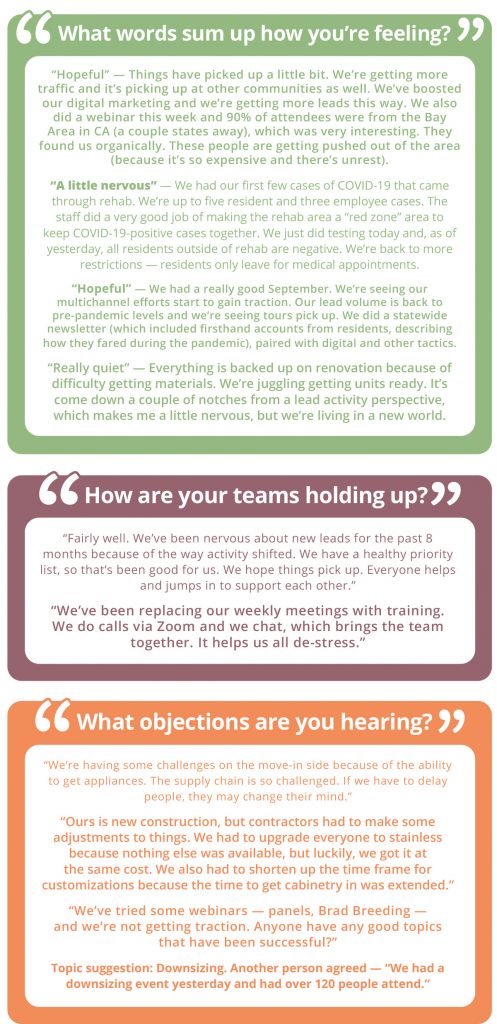From an upswing in sales activities to new concepts in senior living and positive attention from the press, there were lots of successes for our participants this February. However, some attendees struggled with challenges like sales slumps and poor Google reviews — and their fellow participants jumped in with some welcome advice.
Prospects Falling in Love With Communities
The month of love was very busy for Roundtable attendees. There was a major upswing in activity after the holiday slowdown with lots of tours, applications and move-ins. Many communities are at or close to full occupancy. But higher occupancy levels create their own unique problems.

“We’ve had so much success that I don’t have move-in-ready inventory, which is a challenge in itself.” (Missouri)
One creative working solution that an Illinois participant found was marketing guest suites for a trial stay of one to two weeks, in order to “allow those people [who are interested] to try it out for a week or two, and get a feel for living here.” (Illinois)
Unique New Approaches to the Senior Living Concept
Many of the Roundtable attendees had exciting and fresh takes on what senior living can mean, with upcoming projects and expansions underway.
Zen Community
One participant is involved in a “Zen” contemplative care community opening in California later this summer.
“The community will be a contemplative care community with a much different approach to assisted living and memory support than we’ve done in the past. There will be Zen teachers who live in the community, a tea room, and a fully vegetarian offering based on the Greens restaurant in San Francisco. It’s been 10 years in the making.” (Delaware/California)


An On-Site Dog Grooming Spa
One participant added an on-site dog grooming spa. “In one of our apartment buildings, we took over a floor and added a dog grooming spa where we will have a groomer assist residents on campus.” (Arkansas)
Hybrid Home Expansion
Another participant is involved in a “hybrid home” expansion project. “A hybrid home is really the best of an apartment and the best of a cottage or villa. It will be three stories high with an open floor plan. We often hear prospects say they wish they had parking or a garage, and this model has an underground parking structure where every resident can have one car, kept underground and out of the elements.” (Pennsylvania)
Memory Care Village
One participant from New Jersey has plans for developing a memory care village based on the Hogeweyk concept from the Netherlands. “It is a self-enclosed village concept with its own supermarket, cafe, etc., and everything right there on campus. We’re hung up on the zoning process right now and we expect the local town to contest it. The position of the model, that the residents get to live a natural life, is the hook that draws people in. It’s not just dementia care, but dementia living.” (New Jersey)
Media Coverage of On-Campus Fun
A number of participants were able to invite the media to their community, where they got some coverage for fun activities put on to chase away residents’ winter blues.
“We had our indoor snowball fight yesterday! We ended up on the front page of today’s local paper, the local televised news, and even on CBS and ABC news. (Illinois)


ADVICE FROM THE ROUNDTABLE
Navigating Difficult Conversations With Residents
Dealing with an unhappy resident can put staff in treacherous waters, and even more so when the resident is inciting a tirade against the whole community. One participant shared an experience dealing with one such displeased resident, and the Roundtable weighed in with advice.
The Situation:
“We had very little blowback [about rate increases]. The only negative feedback was from just one individual, who seems to have started a campaign with their family and friends to give us 1-star reviews on Google. A lot of it is just not accurate at all. So that’s been a little challenging.” (Arkansas)
The Advice:
“We’ve found that it’s best if the response is quick, and acknowledges what they’ve said — and if you extend the courtesy to please contact as soon as possible and show that you want to learn more about this situation. At that point, you’re really trying to influence the future visitors and viewers as opposed to what they’re actually doing to the Google ratings.” (Pennsylvania)
“Sometimes in those situations, just posting the response and being timely is important. Also, try to drive the conversation offline because what you’re trying to flag for those reading the 1-star reviews is that you care, and that there might be another side to the story.” (Bill Mulligan, Varsity)
Sales Cycle Slumps
One Pennsylvania participant enlisted the Roundtable participants for help with an issue with one of their sales counselors who is in a “slump,” asking, “What do you all do when you have a slow sales cycle and you want to get it kick-started?”
“Maybe you could have a heart-to-heart with them. Ask them if they’re feeling intimidated by an area, or what their knowledge level is, just work with that person.” (Washington state)
“Speaking from personal experience, a number of years ago when I was on the sales side, I went through a slump period. I tried talking to other people and seeing what they were doing, and analyzed my own weak areas. I discovered something about myself, that I spent too much time launching into our community offerings when talking with the prospect rather than getting to know their story first. When I turned that around and focused on the person and said, ‘Tell me more about you,’ it made a really big difference.” (Arkansas)
Learn from your peers at our weekly Sales & Marketing Roundtables. Join us on Thursdays at noon ET, 11 a.m. CT and 9 a.m. PT. For login information, email
